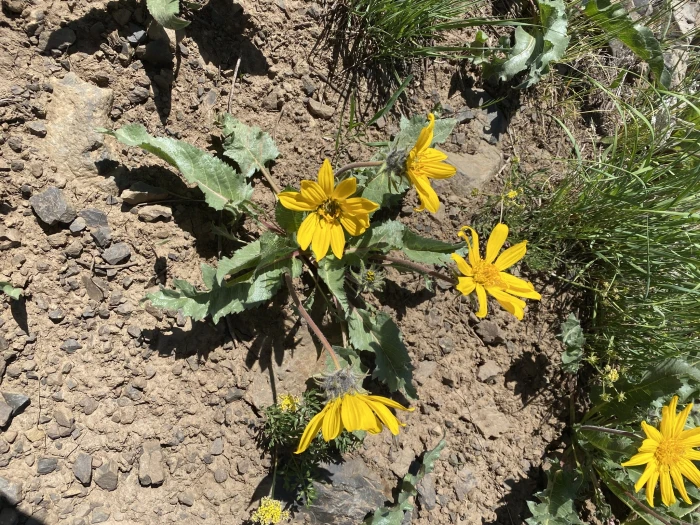Serrate Balsamroot
(Balsamorhiza serrata)
Serrate Balsamroot (Balsamorhiza serrata)
/
/

marek
CC BY 4.0
Image By:
marek
Recorded By:
Copyright:
CC BY 4.0
Copyright Notice:
Photo by: marek | License Type: CC BY 4.0 | License URL: http://creativecommons.org/licenses/by/4.0/ | Rights Holder: marek | Publisher: iNaturalist | Date Created: 2020-05-10T18:39:52Z |




















Estimated Native Range
Climate Requirements for Valdosta, Georgia
| This Plant | Your Site | Plant Suitability for Your Location | ||
|---|---|---|---|---|
| • Precipitation | 8" - 70" | 49" | Aquatic | Aquatic |
| • High Temp. | 69°F - 91°F | 92°F | Your summers may be too hot for this plant. | Too hot |
| • Low Temp. | -16°F - 33°F | 40°F | OK, but your winter temperatures are warmer than normal for this plant | OK |
This plant may not grow well at your location - your precipitation is too high.
Summary
Balsamorhiza serrata, commonly known as serrate balsamroot, is a perennial herb native to the sagebrush steppe and dry mountainous regions of the Western United States, particularly in Washington, Oregon, northern Nevada, and northeastern California’s Modoc Plateau. It is adapted to open, dry, rocky knolls and rock outcrops. This plant typically reaches up to 12 inches tall and is characterized by its basal rosette of toothed, hairy leaves and erect flowering stems. The showy yellow flower heads, which consist of both ray and disc florets, bloom in spring and early summer, attracting pollinators such as bees and butterflies.
Serrate balsamroot is valued for its drought tolerance and its ability to thrive in poor, well-drained, rocky soils, making it an excellent choice for xeriscaping and naturalistic plantings in arid regions. It requires full sun to flourish and is relatively low maintenance once established. In cultivation, it is used for restoration projects, rock gardens, and as a component of native plant landscapes. While it is not commonly afflicted by diseases, its habitat preference should be mimicked to ensure successful cultivation.CC BY-SA 4.0
Serrate balsamroot is valued for its drought tolerance and its ability to thrive in poor, well-drained, rocky soils, making it an excellent choice for xeriscaping and naturalistic plantings in arid regions. It requires full sun to flourish and is relatively low maintenance once established. In cultivation, it is used for restoration projects, rock gardens, and as a component of native plant landscapes. While it is not commonly afflicted by diseases, its habitat preference should be mimicked to ensure successful cultivation.CC BY-SA 4.0
Plant Description
- Plant Type: Herb
- Height: 1.5-2.5 feet
- Width: 1.5-2.5 feet
- Growth Rate: Moderate
- Flower Color: Yellow
- Flowering Season: Spring, Summer
- Leaf Retention: Deciduous
Growth Requirements
- Sun: Full Sun, Part Shade
- Water: Low
- Drainage: Fast, Medium
Common Uses
Bee Garden, Drought Tolerant, Low Maintenance
Natural Habitat
Sagebrush steppe and dry mountainous regions
Other Names
Common Names: Hairy Balsamroot, Serrated Balsamroot, Sawtooth Balsamroot
Scientific Names: Balsamorhiza serrata
GBIF Accepted Name: Balsamorhiza serrata